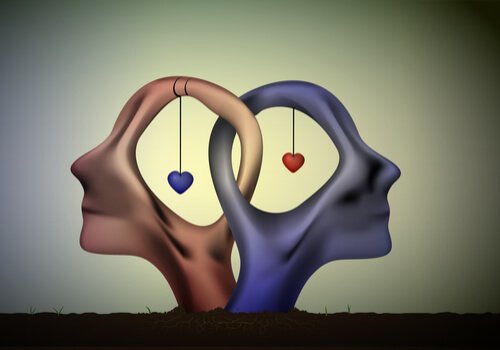You, Me, and Our Committed Relationship: 1+1=3


Reviewed and approved by the psychologist Sergio De Dios González
In this article, we’ll be talking about a new way of understanding a committed relationship: I’m me, you’re you, and then there’s us. Society believes in idyllic patterns and dynamics in relationships. This is a fantasy that, precisely because it’s ideal, becomes a source of many disappointments and a lot of frustration for most of us.
Many people establish romantic connections based on dreams that’ll soon disappoint them. For example, they may think that a relationship must function out of pure love. And although inertia does help, it isn’t enough for a relationship to survive.
Thus, approaching this topic from the perspective of three separate entities allows you to work on the aspects that will make a relationship work. There are two people who love each other and a relationship. Each component is important. In love: 1+1=3. That’s you, the other person, and the committed relationship.
A committed relationship is made up of three separate entities.

The Dimensions
There are three dimensions that must be assessed separately:
- Me. Represents the starting point to loving another person. In order for a relationship to work, you must love yourself first. You should protect the time and space that your own personal growth requires and that enriches your life. Don’t wait for the other person to fill the gaps. It’s good to be introspective and not expect the relationship or the other person to complete you.
- You. At the beginning of every relationship, there’s the idealized “you”. However, you shouldn’t idealize your significant other. They should accept and integrate with your virtues and your flaws. If not, one of you will easily fall into the absurd game of wanting to change the other person into a version of themselves.
- Us. Considering the relationship the third component is to rise above your own individuality and look beyond yourself.
The Third Entity of a Committed Relationship
The third entity of a relationship has its own complexities. This third entity needs our time and affection too. It’s where the levels of affection, communication, a capacity for consensus, the resolution of problems, and sexual desire are cultivated. In short, everything that brings balance and stability to a committed relationship.
You should dedicate time to questions such as: how money is paid and spent, what to do with your leisure time, what kind of activities you enjoy as a couple, and what you like to do when you’re alone. Who handles the relationships with each other’s relatives? What are the limits? Who gets to select your common friends? Which ones do you keep to yourselves? What’s the balance between all of it?

The Four Horsemen of the Apocalypse in a Committed Relationship
These are four common habits that you may have learned after dealing with conflict and its resolution. However, none of them solves anything. In the best case scenario, they just deplete your energy. The habits are criticism, defensiveness, contempt, and talking over others.
There are also certain styles of communication that you be aware of, as they really damage that third entity that is your relationship.
- Aggressive or reactive. Negative verbal communication leads to violence. A person who communicates this way isn’t pleasant to talk to, as they either speak too loudly or too softly and seldom pay attention to what others are saying. Also, their discourse is, for the most part, self-centered, pretentious, and/or dishonest.
- Passive withdrawal. Withdrawal is common in relationships. This is when one of the members fails to directly express their feelings, thoughts, and desires. Instead, they communicate indirectly by frowning, crying, or whispering something under their breath. Furthermore, they may just withhold their feelings and wishes entirely. This harmful non-verbal aggression usually leads to a frustrating quest for dialectic discourse. There’s no room for this kind of communication between people who supposedly love each other. Thus, it should be corrected.
A Concept Often Applied in Therapy
The idea that a couple is comprised of not just two but three interdependent entities is applied in therapy and tends to yield great results. Note that, you don’t need to have problems in your relationship to apply this method. In fact, it’s a good foundation for a successful relationship.
If you understand this concept from the moment you commit to someone and take some time to understand your third entity and take care of, then it’ll be much easier to assess the state of your relationship at any given moment.
This method will allow you to identify your weaknesses and take action to correct them. You’ll also be able to identify your strengths and exploit them to improve your relationship.
In this article, we’ll be talking about a new way of understanding a committed relationship: I’m me, you’re you, and then there’s us. Society believes in idyllic patterns and dynamics in relationships. This is a fantasy that, precisely because it’s ideal, becomes a source of many disappointments and a lot of frustration for most of us.
Many people establish romantic connections based on dreams that’ll soon disappoint them. For example, they may think that a relationship must function out of pure love. And although inertia does help, it isn’t enough for a relationship to survive.
Thus, approaching this topic from the perspective of three separate entities allows you to work on the aspects that will make a relationship work. There are two people who love each other and a relationship. Each component is important. In love: 1+1=3. That’s you, the other person, and the committed relationship.
A committed relationship is made up of three separate entities.

The Dimensions
There are three dimensions that must be assessed separately:
- Me. Represents the starting point to loving another person. In order for a relationship to work, you must love yourself first. You should protect the time and space that your own personal growth requires and that enriches your life. Don’t wait for the other person to fill the gaps. It’s good to be introspective and not expect the relationship or the other person to complete you.
- You. At the beginning of every relationship, there’s the idealized “you”. However, you shouldn’t idealize your significant other. They should accept and integrate with your virtues and your flaws. If not, one of you will easily fall into the absurd game of wanting to change the other person into a version of themselves.
- Us. Considering the relationship the third component is to rise above your own individuality and look beyond yourself.
The Third Entity of a Committed Relationship
The third entity of a relationship has its own complexities. This third entity needs our time and affection too. It’s where the levels of affection, communication, a capacity for consensus, the resolution of problems, and sexual desire are cultivated. In short, everything that brings balance and stability to a committed relationship.
You should dedicate time to questions such as: how money is paid and spent, what to do with your leisure time, what kind of activities you enjoy as a couple, and what you like to do when you’re alone. Who handles the relationships with each other’s relatives? What are the limits? Who gets to select your common friends? Which ones do you keep to yourselves? What’s the balance between all of it?

The Four Horsemen of the Apocalypse in a Committed Relationship
These are four common habits that you may have learned after dealing with conflict and its resolution. However, none of them solves anything. In the best case scenario, they just deplete your energy. The habits are criticism, defensiveness, contempt, and talking over others.
There are also certain styles of communication that you be aware of, as they really damage that third entity that is your relationship.
- Aggressive or reactive. Negative verbal communication leads to violence. A person who communicates this way isn’t pleasant to talk to, as they either speak too loudly or too softly and seldom pay attention to what others are saying. Also, their discourse is, for the most part, self-centered, pretentious, and/or dishonest.
- Passive withdrawal. Withdrawal is common in relationships. This is when one of the members fails to directly express their feelings, thoughts, and desires. Instead, they communicate indirectly by frowning, crying, or whispering something under their breath. Furthermore, they may just withhold their feelings and wishes entirely. This harmful non-verbal aggression usually leads to a frustrating quest for dialectic discourse. There’s no room for this kind of communication between people who supposedly love each other. Thus, it should be corrected.
A Concept Often Applied in Therapy
The idea that a couple is comprised of not just two but three interdependent entities is applied in therapy and tends to yield great results. Note that, you don’t need to have problems in your relationship to apply this method. In fact, it’s a good foundation for a successful relationship.
If you understand this concept from the moment you commit to someone and take some time to understand your third entity and take care of, then it’ll be much easier to assess the state of your relationship at any given moment.
This method will allow you to identify your weaknesses and take action to correct them. You’ll also be able to identify your strengths and exploit them to improve your relationship.
This text is provided for informational purposes only and does not replace consultation with a professional. If in doubt, consult your specialist.







